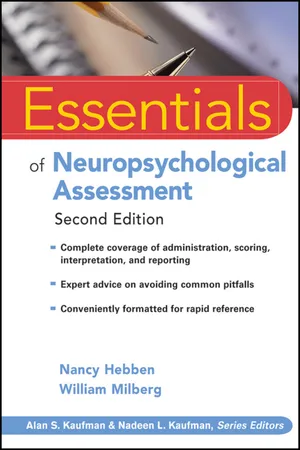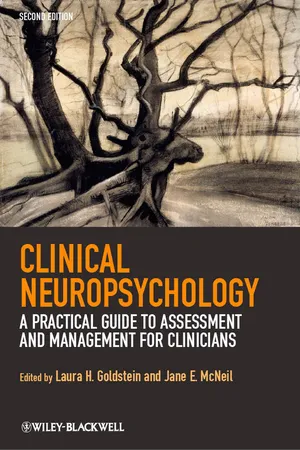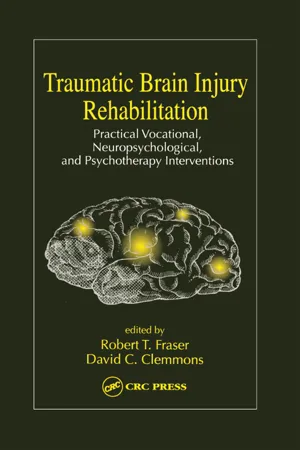Psychology
Brain and Neuropsychology
Brain and neuropsychology focus on understanding the relationship between the brain and behavior. This field explores how brain structure and function influence cognitive processes, emotions, and behavior. Neuropsychologists study the effects of brain injuries, diseases, and disorders on mental functions, and use this knowledge to develop interventions and treatments for individuals with neurological conditions.
Written by Perlego with AI-assistance
Related key terms
1 of 5
11 Key excerpts on "Brain and Neuropsychology"
- eBook - PDF
- Douglas Bernstein, , , (Authors)
- 2015(Publication Date)
- Cengage Learning EMEA(Publisher)
FOUNDATIONS OF NEUROPSYCHOLOGY What is neuropsychology and how did it develop? Neuropsychology is the subfield of psychology whose goal is to explore and understand the relationships among brain processes, human behavior, and psychological functioning. Neuropsychologists study how brain systems, and disruptions of those systems, affect a wide range of human abilities, including cognitive functions (such as language, memory, attention, mathematical, and visual-spatial skills), motor functions (such as walking or threading a nee-dle), emotional functions (such as the ability to express emotions and understand other people’s emotional expressions), and social functions (such as daily interactions with others). They study, too, how the brain affects personality and psychological disorders such as depression. The field of neuropsychology rests on two main assumptions. The first is that many com-plicated mental tasks, such as memory or decision making, involve numerous subtasks that can be tested and studied separately (Lezak, Loring, & Howieson, 2004). For example, as described in earlier chapters, the ability to form a new memory usually requires a person to be awake, to pay attention, to receive sensations, to perceive those sensations, to form mental representations of that information, to be motivated to remember the information, and to have the language or other verbal skills necessary to express the information when it is retrieved from memory. If any of these subtasks fail, a person’s memory function would fail in any number of everyday situations. With this assumption about subtasks in mind, neuropsy-chologists must not only figure out what complicated mental tasks a person can and cannot do but also identify the failure of one or more subtasks that may be at the root of the problem. - eBook - PDF
Introduction to Clinical Psychology
Bridging Science and Practice
- Douglas A. Bernstein, Bethany A. Teachman, Bunmi O. Olatunji, Scott O. Lilienfeld(Authors)
- 2020(Publication Date)
- Cambridge University Press(Publisher)
Neuropsychologists study how brain operations control such processes and how this control breaks down due to brain dysfunction (e.g., phys- ical trauma, stroke, infection, neurodegeneration) or psychological disorders (e.g., posttraumatic stress disorder, depression, schizophrenia). Neuropsychology The field of study that seeks to understand how brain processes make human behavior and psychological functions possible. Clinical neuropsychologists become involved in the psychological and behavioral evaluation of individuals. By doing careful testing of a per- son’s mental abilities and psychological functions, they can learn whether or not the person shows a pattern of impairments suggestive of brain damage, and if so, where in the brain the damage might be. Clinical neuropsychologists also help quantify the severity of psychological deficits by comparing a given person’s performance to the average performance, or norms, established by the previous testing of many other people of similar educational, social, and cultural backgrounds (Werry, Daniel, & Bergström, 2019). Often, the pattern of deficits identified by neuropsychological testing may offer clues to the cause of brain damage. And by testing the same person at different times, neuropsychologists can detect whether a person’s cognitive abilities are improving, worsening, or remaining stable. Clinical neuropsychologists may help to clarify how a person’s problems from brain damage are likely to affect that person’s ability to function socially, vocationally, and in other aspects of daily living. In addition, they can help formulate a regimen for rehabilitation and recovery from the effects of brain damage. Clinical neuropsychologists must use several kinds of knowledge and skills in their work. First, as do other clinical psychologists, they make use of the interviewing, observation, and testing skills described in Chapters 3, 4, and 5. - eBook - ePub
- Nancy Hebben, William Milberg(Authors)
- 2009(Publication Date)
- Wiley(Publisher)
Neuropsychology is usually broadly defined as the study of brain-behavior relationships. Of course, this definition does not capture the multiplicity of questions and approaches that have been used to explore how the central nervous system represents, organizes, and generates the infinite range of human capabilities and actions. Modern neuropsychology includes the study of the classic problems of psychology—attention, learning, perception, cognition, personality, and psychopathology—using techniques that include the methods of experimental psychology as well as the methodologies of test construction and psychometrics. Its scientific palate includes such state-of-the-art technologies as high-resolution structural and functional neuroimaging and other techniques such as computational modeling, and it is beginning to be integrated with genomics and other advanced biological technologies such as proteomics and metabalomics. This book presents some of the core concepts of the particular discipline of clinical neuropsychological assessment. According to a consortium of representatives of a number of professional neuropsychological organizations that convened in 1997 in Houston, Texas, clinical neuropsychology can be defined as “the application of assessment and intervention principles based on the scientific study of human behavior across the lifespan as it relates to normal and abnormal functioning of the central nervous system” (Hannay et al., 1998, p. 161). In practice, this translates into using standardized psychological tests, which are usually designed to assess various aspects of human cognition, ability, or skill, to provide information to a variety of clinical questions about the central nervous system and behavior. Less often, tests of personality or affective behavior have been adapted as neuropsychological instruments.In practice, the question of “normal versus abnormal functioning of the central nervous system” (Hannay et al., 1998, p. 161) is posed in an extremely broad range of clinical situations that includes not only the assessment of the consequences of diseases and physical damage to the central nervous system, but also the consequences of psychiatric conditions in which central nervous system involvement is assumed but not well defined. In some cases, the central nervous system function in question may be abnormal because of a neurochemical rather than a structural abnormality, as might be the case in some metabolic disorders, or because of the presence of a prescription or street pharmacological agent. Neuropsychological assessment is also increasingly being used to assess variations in early development that may be a reflection of variations in the rate of normal maturational processes rather than definable pathology (at least currently). The latter has become so common as a source of clinical referrals for neuropsychological assessment that a new subspecialty known as educational or school neuropsychology has emerged and is becoming an increasingly important part of the role of school-based practitioners of psychology. To capture the breadth of these clinical questions, we use the term brain dysfunction - Anton Yasnitsky, René van der Veer, Michel Ferrari(Authors)
- 2014(Publication Date)
- Cambridge University Press(Publisher)
Mainstream neuropsychology today still takes an approach that Luria called naturalistic. This approach is well described by Kolb and Whishaw (1996): We define neuropsychology as the study of the relation between brain function and behavior. Although the study draws information from many disciplines – for example, anatomy, biology, biophysics, ethology, pharmacology, physiology, physiological psychology, and philosophy – its central focus is the development of a science of human behavior based on the function of the human brain. (p. 3) Most notable in this definition is not the list of disciplines that contribute to neuro- psychology but what is ignored, the disciplines that are not in the list. The list does not include any discipline that studies (human) environment – history, anthropology, culturology, sociology, ethnography, semiotics, etc. Mainstream neuropsychology today searches for an explanation of the behavior in the brain. Cultural-historical psychology, in contrast, does not actually study functions of the brain as the basis of behavior. Rather, this approach studies higher psychological functions from the perspective of the brain. Next I discuss what this statement means. Extracerebral origin of mind in the context of structural-systemic science Cultural-historical neuropsychology comprises a coherent whole. General structural-systemic principles that define what is scientific understanding and expla- nation do not stand alone but are applied at every step. Structural-systemic prin- ciples force us to ask – what is the whole? What are parts of the whole? In which specific way are the parts related so that this and not some other whole emerges? In order to answer these questions, a neuropsychological approach is taken for a very clear reason – cultural-historical neuropsychology is not so much the study of the functions of the brain but rather one particular way (among others) that allows us to study development of higher psychological functions.- eBook - ePub
Neurobehavioral Toxicology: Neurological and Neuropsychological Perspectives, Volume I
Foundations and Methods
- Stanley Berent, James W. Albers(Authors)
- 2012(Publication Date)
- Taylor & Francis(Publisher)
Chapter 6 , for instance, the nervous system can be conceptualized in terms of laterality as well as levels, i.e., supratentorial, posterior fossa, spinal, and peripheral. Neuropsychology can contribute importantly in the determination of abnormality. Neuro-psychological test results, for example, can help localize an abnormality within the CNS, once it has been identified, by differentiating diffuse or generalized impairment from focal involvement, distinguishing probable acute or subacute from chronic disorders, and identifying progressive from resolving conditions. Psychopathology (e.g., major affective or thought disorders) and other psychological factors (e.g., motivation, coping style) are also addressed by neuropsychology. Since the symptoms of psychopathology often mimic neurological disease, the neuropsychologist may be looked to as the primary clinician to answer questions pertaining to the effects of such disorders on the patient's clinical presentation.The brain regulates most human thoughts, feelings, and actions. Because of this, damage to the brain is very likely to be reflected in behavioral symptoms, e.g., expressive aphasia resulting from injury to Broca's area (Mohr, 1976), Parkinsonism as a result of dopaminergic neuronal system dysfunction (Yahr, 1989), and gait disturbance in bilateral frontal lobe disease (Gilman, 1989). The knowledge of predictable relationships between brain and behavior in many instances allows Psychology and Medicine to approach the problem of studying the brain through a combination of deductive reasoning (‘tracing back’ from behavior) and inductive problem-solving (proposing and testing hypotheses generated in the course of the clinical process). Because the brain is not easily accessible to direct observation, behavioral methods represent important and effective approaches to clinical problem-solving and diagnosis. - eBook - ePub
Clinical Neuropsychology
A Practical Guide to Assessment and Management for Clinicians
- Laura H. Goldstein, Jane E. McNeil, Laura H. Goldstein, Jane E. McNeil(Authors)
- 2012(Publication Date)
- Wiley(Publisher)
The answer to this question depends on the setting in which the neuropsychologist is working. The two main areas are academia and clinical (or applied), and there are critical differences between the two. Neuropsychologists in academia drive our understanding of the relationship between brains and behaviour. New ideas regarding brain–behaviour relationships start as theories (e.g., the ‘theory of mind’ theory), which lead to the development of testable hypotheses and new methodologies (e.g., the ‘Sally Ann test’). The hypotheses are investigated under rigorous conditions and validated or modified as the results indicate. Gradually, such theories evolve into accepted paradigms and conceptual frameworks that improve our understanding of neurotypical development or our awareness of how known neurodevelopmental abnormalities may give rise to behavioural dysfunction. Eventually, research tasks may become standardized and commercially available to clinicians.Neuropsychologists in clinical practice can be found in acute care settings, where their assessments contribute to the monitoring and management of medical conditions known to impact neurocognitive functioning (e.g., stroke, metabolic disorders, brain tumours). Specialist advice regarding commissioning of child neuropsychology services, particularly within neurological settings, is available from the British Psychological Society (2004).Although children's mental health services have only recently begun to embed neuropsychological thinking and evaluations into the diagnostic process and intervention planning (Humphreys, 2006), the contribution of neuropsychology to child mental health can be traced to the Isle of Wight study in the 1960s, one of the first epidemiological investigations of child psychiatric disorders. This study documented the link between brain dysfunction and increased risk of psychiatric disorder (Graham and Rutter, 1968). Interestingly, the relationship between cognitive dysfunction in childhood and the risk of mental illness in adulthood - eBook - ePub
Technology in Mental Health
Foundations of Clinical Use
- Jessica Stone(Author)
- 2022(Publication Date)
- Routledge(Publisher)
It is important to take a biopsychosocial approach to humans and their ways of being and functioning, however, to be able to understand the sum of the parts, we must investigate the parts themselves. Neurology, with all the structures, networks, functions, and connections, is a foundation to function, emotion, and behavior. The mind is a window to the self, as well as the intertwining of self and other. The body is our vehicle to function, exploration, relationship, and communication. All have importance in psychology, therefore all must be considered and included. Inclusion of the New If we are going to include the new in our direct clinical work, caution is always important. The newest, most interesting hardware or software may initially engage, but it is the analysis and inclusion of the minutiae which allow us to confidently and competently incorporate the new and understand the why. An emphasis of knowing the “what, how, and why” regarding any approaches used in a clinical capacity allows the clinician the ability to move freely within well-understood professional boundaries and foundations. Knowing what the criteria and components are allows the clinician to vet the future new for clinical inclusion. Brain, Mind, and Body The connections of the brain, mind, and body are undeniable at this time in history. Remaining cognizant of the importance of these connections will allow the clinician to serve their clients well, as even if we think we are speaking to and with one portion of the brain, we are actually activating millions of neurons throughout the brain, mind, and body. Even if we are not aware of the magnitude of the process, holding space and recognition for the responses is important. According to Damasio, the body provides the point of reference, the mind exists for an integrated internal system, and there has been an important interplay between the body and brain throughout evolution as a species and during an individual's development (2005) - eBook - PDF
- William O′Donohue, Richard F Kitchener, Richard F Kitchener, William O′Donohue(Authors)
- 1996(Publication Date)
- SAGE Publications Ltd(Publisher)
CHAPTER 1 5 N EU ROBEHAVIORAL SC I ENCE, N EU ROPSYCHOLOGY, AN D TH E PH I LOSOPHY OF MI N D Karl H. Pribram INTRODUCTION The advent of the cognitive revolution in psychol-ogy ushered in a resurgent interest in the mind! brain connection. In this essay I discuss three forms this interest has taken. Neurobehavioral sci-ence, based to a large extent on animal brain-behavioral research, has made strides in determin-ing the nature of memory storage, and the brain systems involved in attention and in different sorts of learning. Currently the neurochemical basis of emotion and motivation is being clarif ied. Clinical neuropsychology has added to the neurobehav-ioral base, and has been supplemented by it: An examination of memory retrieval processes and the exploration of brain function in the organiza-tion of human consciousness needs a human popu-lation to study. The yield has been rewarding and has given rise to a reexamination by philosophers and others of the nature of mind and spirit as these relate to the material world. 207 NEUROBEHAVIORAL SCIENCE Parts and Wholes Three closely related issues concerning the organi-zation of brain function have been the subj ect of controversy for two centuries. The first of these concerns localization versus distribution of func-tions within the brain. The second issue stems from the first: Does processing proceed among different localizable systems or modules in a hierarchical fashion, or is processing global and heterarchical? Finally, is processing within and between systems serial or parallel? Toward the end of the eighteenth century, Gal l brought these issues to the fore by correlating dif-ferent local brain pathologies to the histories of the cadavers he autopsied. Though often wrong in detail, Gall was correct in the methods he carefully detailed (see Gall & Spurtzheim, 1 809/1969). He was naive in delineating the faculties of mind for - eBook - ePub
Clinical Psychology
A Global Perspective
- Stefan G. Hofmann(Author)
- 2017(Publication Date)
- Wiley-Blackwell(Publisher)
Unfortunately for Mary, there is no current treatment that can cure Alzheimer's disease. However, for other disorders for which there are known interventions, neuropsychological assessment can also be used to track progress and to suggest specific treatments. For example, individuals with normal pressure hydrocephalus (NPH), a condition that causes an abnormal buildup of cerebrospinal fluid in the brain, can be treated with surgical intervention. Patients with NPH are often evaluated before and after a surgical intervention to help determine if the treatment was successful (e.g., Solana, Sahuquillo, Junqué, Quintana, & Poca, 2012). Results from a neuropsychological evaluation can also be used to suggest specific interventions that build on a patient's strengths. As an example, patients with memory deficits can be placed in rehabilitation programs that teach skills that rely on their other domains of intact cognitive functioning to improve their adaptive functioning (e.g., Greenaway, Hanna, Lepore, & Smith, 2008).The practice and use of neuropsychological assessment varies across different parts of the world. As a field, clinical neuropsychology is most “professionalized” within the United States and Europe, and the major textbooks, testing instruments, and research in the field reflect a predominantly Western and individualistic cultural lens. The growth of forensic neuropsychology, a specialty area within the field that focuses on neuropsychological assessment of criminal or civil litigants, underscores this bias.Classification of Behavior and Cognition in Neuropsychological Assessment
As previously reviewed, neuropsychological assessment includes evaluating for changes in a person's patterns of thinking or behaving that might reflect signs of underlying brain injury or disease. In clinical practice, neuropsychologists have found it helpful to conceptualize patterns of behavior within a framework that includes three broad functional systems. These three systems include: (a) cognition, which is the information handling aspect of behavior; (b), emotionality, which concerns feelings and motivation, and (c), executive functions, which have to do with how behavior is expressed (Lezak, Howieson, Bigler, & Tranel, 2012). Each of these systems consists of several narrower constructs that collectively contribute to behavior and can be examined more closely within the context of a neuropsychological assessment. We review some of the most important constructs within each of the three broad systems below:Cognition - eBook - ePub
Traumatic Brain Injury Rehabilitation
Practical Vocational, Neuropsychological, and Psychotherapy Interventions
- Robert Fraiser, Robert Fraiser, David C. Clemmons(Authors)
- 2017(Publication Date)
- Routledge(Publisher)
Principles of Behavioral Neurology. Philadelphia, PA: F.A. Davis Company. A closely related field to neuropsychology is behavioral neurology. Composed primarily of neurologists, the field parallels and overlaps a great deal with neuropsychology due to the fact that both fields examine brain-behavior relationships. This text covers in depth the neurophysiology of brain function and dysfunction, and provides a clinical approach to evaluating various neurological conditions. A fine description of neuropsychological testing of older adults appears in this text, and is an example of how behavioral neurology and neuropsychology cover common professional and academic ground.Kolb, B. and Whishaw, I.Q. (1990). Fundamentals of Human Neuropsychology. Third Edition. New York: W. H. Freeman and Company. Understanding basic neuroanatomy and neurophysiology of the brain is foundational to understanding brain-behavior relationships. Kolb and Whishaw’s text provides such a foundation for those interested in examining the central nervous system in greater detail. This text is frequently used in graduate training programs as an introductory text to the physiological aspects of brain functioning. It is well-illustrated and easily read by the non-neuropsychologist.Prigatano, G.P. and Schacter, D.L. (Eds.). (1991). Awareness of Deficit After Brain Injury: Clinical and Theoretical Issues. New York: Oxford University Press. Neurobehavioral syndromes complicate the process of brain injury rehabilitation and add another dimension to the process of vocational reentry for the client with brain injury. These authors describe well what is known as deficit awareness syndromes in a range of brain disorders, including traumatic brain injury. This is a thoughtful volume that not only covers critical research issues but also clearly describes the clinical dilemmas that arise when working with an individual who evidences these problems.Luria, A.R. (1973). The Working Brain: An Introduction to Neuropsychology - eBook - PDF
- Rik Carl D'Amato, Elaine Fletcher-Janzen, Cecil R. Reynolds, Rik Carl D'Amato, Elaine Fletcher-Janzen, Cecil R. Reynolds(Authors)
- 2010(Publication Date)
- Wiley(Publisher)
As previously detailed in this text, many of these individu als call themselves school neuropsychologists. The school neuropsychologist has access to a population of learners referred with disorders having neurogenic eti ologies. Such disorders include, but are not limited to, learning disorders, head injury, seizure disorders, genetic disorders, neurodevelopmental disorders, and disorders of attention. All of these represent a patient population that is shared by both the neuropsychologist and the school psychologist. By providing neu ropsychological services in the school setting, students referred for such services are able to take advantage of having the same professional who administers the neuropsychological assessment the one who follows up with implementation and/or consultation of psychological and educational interventions. Thus, school neuropsychologists as well as some school psychologists are able to link assess ment with intervention and provide ecologically relevant neuropsychological in terventions for students in a learning environment. Finally, it should be noted that it is the school neuropsychologist who is able to bridge the gap between tra ditional psychoeducational assessment and neuropsychological assessment and provide an integrated and comprehensive interpretation of ability. H I STORY OF COGNI TI VE ABILI T Y The history of cognitive ability can be traced by looking at the conceptualization of intelligence. Though early conceptualizations of intelligence, based on intelli gence tests, were atheoretical, later concepts of intelligence have incorporated Assessing and Understanding Brain Function 305 theoretical models as the basis for test construction. Neuropsychological assess ment in North America also has a tradition of being atheoretical. However, with the incorporation of theoretical cognitive ability testing, neuropsychological test construction has begun to embrace a theoretical orientation.
Index pages curate the most relevant extracts from our library of academic textbooks. They’ve been created using an in-house natural language model (NLM), each adding context and meaning to key research topics.










